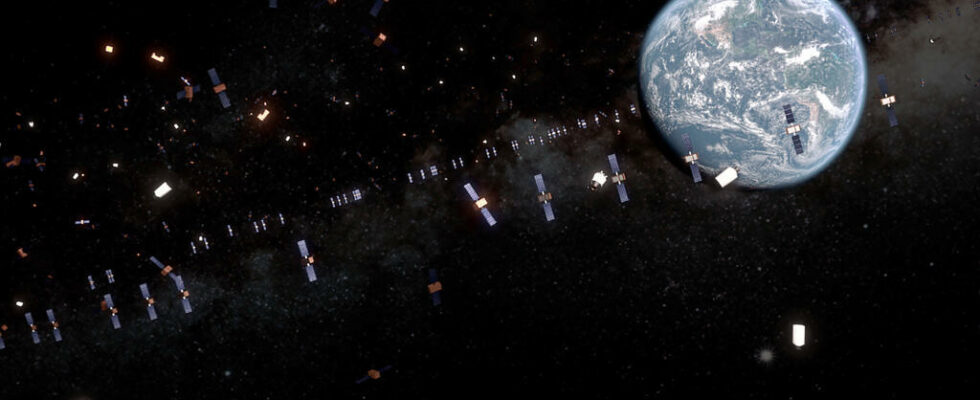If uncertainties remain about the nature of the object that fell from the sky on a village in Kenya at the end of December, such episodes are likely to multiply with the proliferation of space debris.
4 mins
Kenyan authorities announced last week the opening of an investigation into the fall of a space object. On Monday afternoon, a large metal circle crashed at breakneck speed near the small village of Mukuku, in Makueni County, in the south of the country. According to the KSA, the Kenyan Space Agency, this object is space debris.
She first mentioned a separation ring of a rocket. But other hypotheses about the object’s provenance quickly emerged. Asked about one of them, a KSA official clarified on Friday that they could not at this stage “ remove anyone’s responsibility “.
Also readKenyan space agency launches investigation after debris falls from sky
Unidentified falling object
There are many hypotheses, with some experts interviewed by AFP even doubting that it was an object falling from space. For Romain Lucken, boss of Aldoria, a French startup specializing in satellite monitoring, the hypothesis of debris “ is absolutely plausible “. According to him, it would be part of the upper stage of the PSLV (Polar Satellite Launch Vehicle) developed by the Indian Space Agency.
“ There is a mission which was sent on December 30 with a re-entry date which corresponds well and above all a re-entry point which corresponds very well, within a few tens of kilometers “, he explains to AFP. Aldoria, which has 15 telescopes around the world, searches for information on launches and then reconstructs the trajectory by knowing “ typical trajectories at each of the main launch sites “.
“ I’m not even totally convinced that the ring is space debris. », argues Jonathan McDowell, American expert in astronomy who helped identify a piece of the International Space Station that fell on a house in Florida in April 2024. He studied several hypotheses, including that of the atmospheric reentry of a part of the Ariane V184 rocket, in 2008, while noting that the mass did not correspond. “ This part does not belong to an element of a European launcher operated by Arianespace », Reacted the French group questioned by AFP on this hypothesis.
John Crassidis, professor at New York University SUNY who works with NASA on space debris, judges for his part that the technical evaluations of the Kenyan agency “ are 100% accurate » and that they will succeed « to determine which country this comes from because each country does things a little differently “. “ This could be a ring not from the rocket itself, but from the upper stage, which tends to be smaller “, he told AFP.
According to Christophe Bonnal, French specialist in space pollution, the object could come from a military launcher. “ They are armored, this would corroborate the fact that it is very massive and heavy “, he said. But it could also come from an excavator or a tank, he added.
The dangers of a bad fall
These episodes have not yet caused any deaths, but they are becoming more and more frequent with the multiplication of launches. “ Ten years ago, an object capable of creating impact fragments re-entered the atmosphere approximately every two weeks, now this can happen twice a week », Underlines Stijn Lemmens, debris specialist at the European Space Agency (ESA).
Also readOrbital pollution, a new economic challenge for the space industry
“ This will end up falling on critical infrastructure like a nuclear power plant or an oil tanker, on homes », warns Romain Lucken. “ This is our sword of Damocles », agrees Christophe Bonnal. But geography helps, he adds, since the Earth is 71% covered by oceans and 10% by deserts and there are “ that 3.3% of the earth’s surface is densely populated “.
There are some 30,000 cataloged pieces of space debris larger than 10 centimeters and more than a million larger than 1 centimeter and they are all potentially “ dangerous », According to Romain Lucken. “ The catalog does not include different military objects. If it’s a piece of an American missile, we may never know », also notes Christophe Bonnal. John Crassidis talks about Russia and China which does not respectaccording to him, “ no rules » in this matter.
In Europe, regulations require operators to put in place measures to “ either make controlled reentries into uninhabited areas in the South Pacific, or ensure that the objects will be completely destroyed », underlines Romain Lucken. “ But that’s the theory. Once the mission is launched, anything can happen. And no one is going to condemn them to pay compensation if there is an accident », he concludes.
Also readFaced with space debris, Europe wants to clean up in orbit
